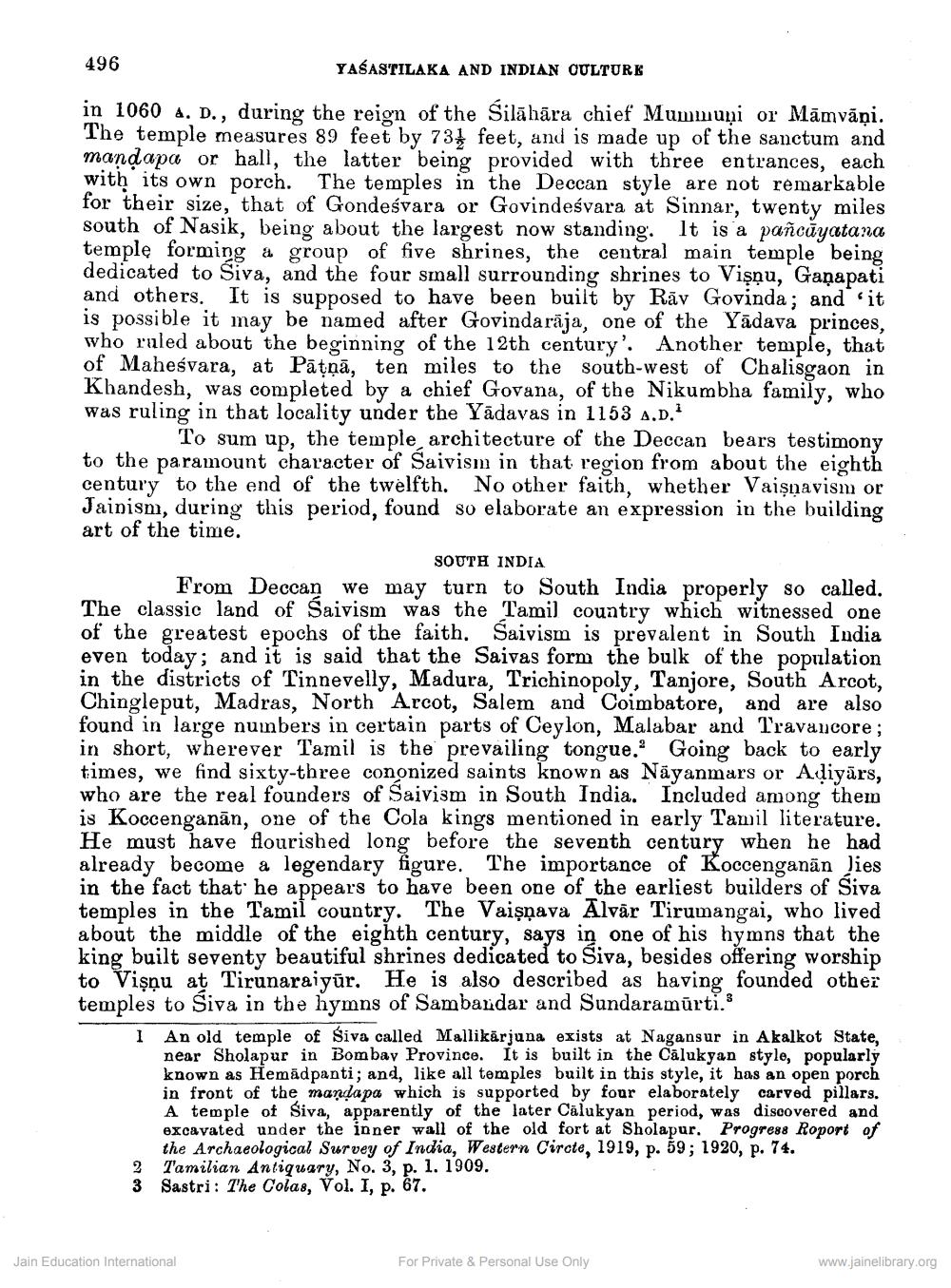________________
496
YAŠASTILAKA AND INDIAN CULTURE
in 1060 A, D., during the reign of the Silāhāra chief Mummuņi or Māmvāņi. The temple measures 89 feet by 731 feet, and is made up of the sanctum and mandapa or hall, the latter being provided with three entrances, each with its own porch. The temples in the Deccan style are not remarkable for their size, that of Gondesvara or Govindeśvara at Sinnar, twenty miles south of Nasik, being about the largest now standing. It is a pañcāyatana temple forming a group of five shrines, the central main temple being dedicated to Siva, and the four small surrounding shrines to Vişnu, Ganapati and others. It is supposed to have been built by Rãv Govinda; and it is possible it may be named after Govinda räja, one of the Yādava princes, who ruled about the beginning of the 12th century'. Another temple, that of Maheśvara, at Pātnā, ten miles to the south-west of Chalisgaon in Khandesh, was completed by a chief Govana, of the Nikumbha family, who was ruling in that locality under the Yādavas in 1153 A.D.
To sum up, the temple architecture of the Deccan bears testimony to the paramount character of Saivism in that region from about the eighth century to the end of the twelfth. No other faith, whether Vaişnavism or Jainism, during this period, found so elaborate an expression in the building art of the time.
SOUTH INDIA From Deccan we may turn to South India properly so called. The classic land of Saivism was the Tamil country which witnessed one of the greatest epochs of the faith. Saivism is prevalent in South India even today; and it is said that the Saivas form the bulk of the population in the districts of Tinnevelly, Madura, Trichinopoly, Tanjore, South Arcot, Chingleput, Madras, North Arcot, Salem and Coimbatore, and are also found in large numbers in certain parts of Ceylon, Malabar and Travancore; in short, wherever Tamil is the prevailing tongue. Going back to early times, we find sixty-three cononized saints known as Nayanmars or Adiyārs, who are the real founders of Saivism in South India. Included among them is Koccenganān, one of the Cola kings mentioned in early Tamil literature. He must have flourished long before the seventh century when he had already become a legendary figure. The importance of Koccenganan Jies in the fact that he appears to have been one of the earliest builders of Siva temples in the Tamil country. The Vaişņava Alvār Tirumangai, who lived about the middle of the eighth century, says in one of his hymns that the king built seventy beautiful shrines dedicated to Siva, besides offering worship to Vişņu at Tirunaraiyūr. He is also described as having founded other temples to Siva in the hymns of Sambandar and Sundaramürti.
An old temple of Siva called Mallikarjuna exists at Nagansur in Akalkot State, near Sholapur in Bombay Province. It is built in the Cālukyan style, popularly known as Hemädpanti; and, like all temples built in this style, it has an open porch in front of the manda pa which is supported by four elaborately carved pillars. A temple of Siva, apparently of the later Calukyan period, was discovered and excavated under the inner wall of the old fort at Sholapur. Progress Roport of
the Archaeological Survey of India, Western Circte, 1919, p. 59; 1920, p. 74. 2 Tamilian Antiquary, No. 3, p. 1. 1909. 3 Sastri: T'he Colas, Vol. I, p. 67.
Jain Education International
For Private & Personal Use Only
www.jainelibrary.org




